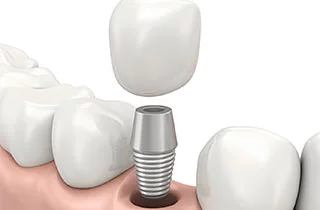Are you missing a tooth and wondering how best to close this gap? Dental implants are today one of the most modern and popular solutions – stable, long-lasting, and visually almost indistinguishable from real teeth. But: They are not the ideal choice for everyone. Whether an implant is suitable for you always depends on a precise medical examination. No need to worry, we’ll look at it together. This article is aimed at people who have lost a tooth and want comprehensive information on whether a dental implant is the right solution for them – from the initial consultation to the final crown, explained understandably and step by step.
From this article, you will learn the following:
- How are dental implants done step by step?
- What are the three stages of dental implants?
- Can an implant be inserted immediately?
How are dental implants done step by step?
The dental implant process involves several precise steps to ensure long-term success. Here’s a simplified breakdown of what to expect:
- Initial consultation: Dental consultation X-rays, and treatment planning
- Tooth extraction (if needed): Removal of the damaged tooth before implant placement
- Bone grafting (if needed): Strengthens the jawbone for implant support
- Implant placement: A Titanium post surgically inserted into the jawbone
- Healing & osseointegration: Bone fuses with the implant
- Abutment placement: The Abutment is attached to the implant
- Crown placement: A custom-made crown is secured insert. Dental bridge or implant?
How painful is getting a dental implant?
Most patients report that getting a dental implant is less painful than expected. The procedure itself is performed under local anaesthesia, so you shouldn’t feel any pain during surgery. What to expect:
- During the procedure: You’ll feel pressure, but not pain
- After the procedure: Mild soreness and swelling for 2–5 days
- Pain management: Usually controlled with over-the-counter painkillers
- Long-term discomfort: Rare if healing goes as planned
What type of anaesthesia is used for implants?
Depending on your comfort level or the complexity of the case, other options may also be available:
- Local anesthesia: Standard option, numbs only the treatment area
- Conscious sedation: Helps reduce anxiety while keeping you awake
- IV sedation: A deeper level of sedation, often used for longer procedures
- General anaesthesia: Rarely used, typically for complex surgical cases
OUR dentist or oral surgeon will help choose the most appropriate option based on your needs and medical history.
What are the three stages of dental implants?
- Implant Placement – The dentist surgically inserts the titanium post into the jawbone, which acts as the artificial tooth root.
- Osseointegration and Healing – Over 3 to 6 months, the bone naturally fuses with the implant in a process called osseointegration.
- Abutment and Crown Placement – Once healed, a small connector (abutment) is attached to the implant, followed by a custom-made crown to restore function and appearance. Read more about different types of dental implants
How long does it take to place a dental implant?
A complete dental implant procedure usually takes 3-9 months, depending on your oral health and whether any preparatory treatments (such as bone grafting) are needed. Here is a general timeline:
- Implant placement: 1-4 hours, depending on the number of implants
- Healing and ossification: 3-6 months for the bone to fuse with the implant
- Superstructure and crown placement: in OUR CLINICS during 5 days after healing. How long do dental implants last ?
If bone grafting is required, it may take an additional 3-6 months before the implant can be placed.
How long will I be ill after implantation?
Most people experience only mild discomfort after dental implant surgery and are not seriously ill or bedridden. Here’s what you can expect:
- Swelling and soreness: Usually lasts 2–5 days
- Minor bleeding or bruising: Can occur for 1–2 days
- Soft diet: Recommended for about 1 week
- Back to work: Most return within 1–2 days
Full healing of the implant site takes longer, but daily life usually returns to normal very quickly. Pain is generally manageable with over-the-counter medication. Read about problem with the implantation
Can an implant be inserted immediately?
Yes, in some cases, a dental implant can be placed immediately after tooth extraction, known as “immediate implant placement“. However, this depends on several factors:
- Healthy jawbone: Must be strong enough to support the implant
- No infection: The extraction site must be free of infection or inflammation
- Good oral health: Overall gum and bone condition must be stable
- Correct timing: Performed right after extraction by an experienced surgeon
While immediate implants can save time and reduce surgical sessions, our dentist will determine if you’re a suitable candidate after a thorough evaluation. Dental implants in Hungary are 50-70% cheaper


